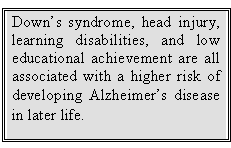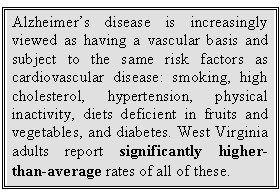RISK FACTORS FOR DEMENTIA
The greatest risk factor for Alzheimer’s disease is age. While about 10% of people in the United States over the age of 65 have AD, it is estimated that nearly 50% of those over age 85 are at risk for developing the disease (21). Women are more likely than men to develop AD; this may be age-related, as women live longer than men.
Research has also shown that individuals with a family history of AD are more likely to have the disease themselves (21). People who have a specific version of the apoE gene (i.e., apoE 4), which is found on chromosome 19, have been found to be several times more likely to develop late-onset AD than those who have another version of that gene (22). In 2000, three separate studies found that chromosome 10 might also have genes that increase a person’s chances of developing late-onset AD (23). Early-onset AD is even more likely to run in families. Scientists have found that families with a history of early-onset AD have a mutation in selected genes on chromosomes 21, 14, and 1. Children who have one parent with the mutation have about a 50-50 chance of developing early-onset AD (24).
 Oxidative
damage is being investigated as a possible contributor to AD.
It has been suggested that damage from free radicals can accumulate in
neurons, eventually resulting in a loss of function (25). The brain’s
high rate of metabolism and the longevity of its cells make it vulnerable
to this type of damage over the course of a person’s life span. Inflammation in
the brain is another possible factor in the development of AD. The types
of cells and compounds normally involved in inflammation have been found
in AD plaques, leading some scientists to suggest that these aid in the
development of the plaques that ultimately cause the neurons to die (25).
A study that analyzed the medical records of World War II veterans linked head
injury in early adulthood to AD in later life (26). The authors
speculated that brain trauma can trigger a degenerative process that
eventually results in the development of AD.
Oxidative
damage is being investigated as a possible contributor to AD.
It has been suggested that damage from free radicals can accumulate in
neurons, eventually resulting in a loss of function (25). The brain’s
high rate of metabolism and the longevity of its cells make it vulnerable
to this type of damage over the course of a person’s life span. Inflammation in
the brain is another possible factor in the development of AD. The types
of cells and compounds normally involved in inflammation have been found
in AD plaques, leading some scientists to suggest that these aid in the
development of the plaques that ultimately cause the neurons to die (25).
A study that analyzed the medical records of World War II veterans linked head
injury in early adulthood to AD in later life (26). The authors
speculated that brain trauma can trigger a degenerative process that
eventually results in the development of AD.
The Alzheimer’s Society reports that individuals with Down’s syndrome (trisomy 21) have a higher incidence of developing AD in middle age (27). The prevalence of dementia in people with other learning disabilities is four times higher than that in the general population (27). Low educational achievement has been found to lead to an increased risk for AD in other studies (28).
Some researchers have been studying the associations between AD and exposure to environmental toxins. A study from Case Western Reserve University found that people working in jobs that involved high levels of lead exposure were 3.4 times more likely to develop AD (29). Other studies have examined the roles of aluminum and mercury in the development of AD, but results have been mixed. Scientists at the University of Calgary Faculty of Medicine published findings in 2001 showing that exposure to mercury in animal subjects caused the formation of neurofibrillary tangles, one of the markers for AD (30). An earlier Swiss study linked mercury exposure to amyloid plaques in animal tests (31). Other studies have found an association between brain degeneration in animals and the mercury in dental amalgams (32), but a 1999 study at the University of Kentucky found no such link in human subjects (33).
Cerebral infarctions (strokes) are associated with vascular dementia, especially in the elderly, and impaired cognitive function. A recent study published in Neurology found a twofold increase in the risk of vascular dementia following a cerebral infarction (34). The risk increased with multiple, large, or clinically evident strokes.
A 2003 study by Honig et al. has linked stroke with an increased risk of Alzheimer’s disease as well (35). The relationship was found to be strongest when stroke was accompanied by known cardiovascular risk factors, i.e., hypertension, diabetes, and heart disease. The authors offer two possible explanations for the association: (1) poor vascular health in the brain may accelerate AD symptoms and (2) an underlying physiological cause may make some people more prone to both AD and stroke.

The connection between Alzheimer’s disease and vascular dementia is of great interest to scientists as more is learned about each disorder. Autopsy results suggest that dementia caused solely by vascular abnormalities is rare, while AD is increasingly viewed as having a vascular basis and subject to the same risk factors as stroke and other cardiovascular illness, such as smoking, high cholesterol, hypertension, physical inactivity, diets deficient in fruits and vegetables, and diabetes. The blood vessel damage caused by these and other risk factors may result in the production of the proteins that then kill the nerve cells and leave behind the characteristic plaques and tangles of AD.
Table 1 below contains 2003 West Virginia and United States prevalence rates for these risk factors. The state’s rates of all six risk factors were statistically significantly higher than the national rates.
| Table
1. Prevalence (%) of Selected Risk Factors* Among Adults (18
and Older) West Virginia and United States (Median) 2003 Behavioral Risk Factor Surveillance System |
||||||
|---|---|---|---|---|---|---|
Risk Factor |
Total |
Male |
Female |
|||
|
WV |
US |
WV |
US |
WV |
US |
Cigarette Smoking1 |
27.3 |
22.0 |
27.6 |
24.7 |
27.1 |
20.2 |
High Cholesterol2 |
38.1 |
33.1 |
33.8 |
33.8 |
41.7 |
32.1 |
Hypertension3 |
33.6 |
24.8 |
35.0 |
25.0 |
32.3 |
24.9 |
Physical Inactivity4 |
28.0 |
23.1 |
24.9 |
20.8 |
30.9 |
24.9 |
Poor Nutrition5 |
81.3 |
77.4 |
84.9 |
82.3 |
77.9 |
73.0 |
Diabetes6 |
9.8 |
7.2 |
8.7 |
7.3 |
10.8 |
7.0 |
*Factors that are currently viewed as potential risks for developing dementia.
Source: http://www.cdc.gov/brfss/
Coronary artery bypass surgery has also been linked to cognitive decline. Researchers at Duke University Medical Center reported in 2001 that among 261 patients who underwent bypass surgery 53% showed cognitive decline at discharge, 24% at six months, and 42% at five years (36). Mild cognitive impairment before surgery was a predictor of more severe long-term cognitive impairment following surgery. The use of heart-lung machines has been suggested as a cause, through the release of embolic
material that can enter the cerebral vessels during surgery (37). The Duke researchers suggest a different theory: The heart-lung machine reduces blood flow throughout the body during surgery, resulting in less blood flow to the intestines, starting a process whereby bacteria enter the bloodstream, causing inflammation in the brain (38). Bypass surgeries performed without a heart-lung machine and other surgeries such hip replacements can also result in increased dementia, however, causing some researchers to focus instead on the role of anesthesia (39). Research continues to be performed on factors of surgical procedures that may impact long-term cognitive function.
1 Currently smokes cigarettes.
2 Has been told by a health professional that blood cholesterol level is high.
3 Has been told by a health professional that he/she has high blood pressure.
4 Reported no physical activity during the month prior to the interview.
5 Consumes fewer than five fruits and vegetables per day.
6 Has been told by a health professional that he/she has diabetes.